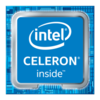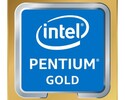Intel Core i5-8210Y vs Intel Celeron N5095A vs Intel Pentium Gold 6500Y
Intel Core i5-8210Y
► remove from comparisonThe Intel Core i5-8210Y is a very efficient dual-core SoC for (passively) cooled notebooks based on the Amber Lake generation and was announced on 30th October 2018 with the new MacBook Air. The CPU consists of two processor cores clocked at 1.6 - 3.6 GHz and a TDP of 7 Watt. Thanks to Hyper Threading, the processor can execute up to four threads simultaneously. The chips also includes the Intel HD Graphics 617 GPU, a dual-channel memory controller (DDR3L/LPDDR3) as well as VP9 and H.265 video de- and encoder. Compared to the Kaby Lake-Y predecessors (e.g. Core i7-7Y75), Amber Lake uses the same architecture produced in the improved 14nm+ FinFET process (no 14nm++) but offers higher clock speeds at an increased TDP rating. The Core i5-8200Y is very similar when configured to 7 Watt (cTDP up) and offers even higher Turbo clocks, but a slightly slower GPU (-100 MHz).
Architecture
Intel basically used the familiar micro architecture from the Skylake / Kaby Lake generation, so the per-MHz performance is identical.
Performance
The performance of the Y series is highly depending on the cooling solution of the laptop / tablet and the TDP settings for sustained load. Therefore, the differences between a Core m3 and a i7 may be rather slim, if the thermals are very limited. The high Turbo clock speeds in Amber Lake should however lead to a very good single thread performance for short bursts.
Graphics
The integrated Intel HD Graphics 617 GPU has 24 Execution Units (EUs) like the old HD Graphics 515 and runs with clocks between 300 and 1050 MHz in combination with this processor. The performance heavily depends on the TDP limit as well as the memory configuration; with fast LPDDR3-1866 RAM in dual-channel mode, the GPU should sometimes be able to compete with the HD Graphics 520, but can also be much slower in other scenarios. Modern games from 2016 will, if at all, only run smoothly in the lowest settings.
Contrary to Skylake, Kaby Lake and Amber Lake now also supports hardware decoding for H.265/HEVC Main10 with a 10-bit color depth as well as Google's VP9 codec.
Power Consumption
The chip is manufactured in the 14 nm+ process with FinFET transistors. The typical TDP for the Amber Lake Y-series is specified at 5 Watts, but the i5-8210Y is specified at 7 Watt (for the MacBook Air).
Intel Celeron N5095A
► remove from comparison
The Celeron N5095A is an inexpensive quad-core SoC of the Jasper Lake product family designed for use in affordable SFF desktops and laptops. It features four Tremont CPU cores running at 2 GHz that Boost to up to 2.9 GHz with no thread-doubling Hyper-Threading technology in sight. A pretty basic iGPU is present as well.
The only difference between the N5095A and the N5095 is that the former comes with support for more proprietary Intel technologies such as the Smart Sound DSP, Wake on Voice and HD Audio.
Architecture and Features
Tremont brings many improvements over Goldmont Plus, the architecture that we know from the N5030 and myriads of other N-class CPUs. An up to 30% boost in single-thread performance is to be expected thanks to smarter prefetchers, branch prediction improvements and other refinements, according to Intel. These new chips are physically larger than their immediate predecessors as a result. Either way, this is still a "small" core rather than a "big" one according to ChipsAndCheese.
The Celeron has 1.5 MB of L2 and 4 MB of L3 cache and is compatible with DDR4-2933 and LPDDR4x-2933 memory or slower. Support for Intel CNVi Wi-Fi 6 modules is baked into the chip, as are 8 PCIe 3.0 lanes for NVMe SSD speeds up to 3.9 GB/s. USB 4 or Thunderbolt aren't supported however.
Please also note that the Celeron gets soldered to the motherboard (BGA1338 socket interface) for good and is thus not user-replaceable.
Performance
While we haven't tested a single system featuring the N5095A as of Sep 2024, we have done several reviews of computers/laptops powered by the N5095. CPU performance should be pretty much identical between the two. Therefore, we fully expect the chip to be about as fast as the Core i3-10110U, Core i3-1005G1, Celeron N5105 and also the Ryzen 3 3200U in multi-threaded workloads. Which is just enough for the most basic of tasks in late 2024.
Performance will get a significant hit if the power target is set to 10 W or 6 W instead of the Intel-recommended 15 W value.
Graphics
The DirectX 12.1-capable 16 EU UHD Graphics runs at up to 750 MHz and is in many respects similar to what Ice Lake CPUs come equipped with. This graphics adapter is capable of driving up to 3 SUHD displays simultaneously; HEVC, AVC, VP9, MPEG-2 and other popular video codecs can all be hardware-decoded. AV1 and VVC can't.
As far as gaming is concerned, it is reasonable to expect playable framerates in really old games (like Dota 2 Reborn) provided one sticks to lower resolutions such as HD 720p.
Power consumption
While most N-class chips have a 6 W long-term power target, the Celeron N5095A has a 15 W TDP to mimic much faster U-class Core processors. This isn't a great CPU for passively cooled designs.
The N5095A is built with the same 10 nm Intel process as Ice Lake-U processors for pretty unimpressive power efficiency, as of late 2024.
Intel Pentium Gold 6500Y
► remove from comparison
The Intel Pentium Gold 6500Y is an energy-efficient, dual-core SoC designed for use in Windows tablets and passively cooled laptops. The Pentium is based on the old Amber Lake architecture that was initially introduced in 2018. The CPU was unveiled in Q1 2021; it is, in fact, not very different from Intel Core m3-8100Y, the only difference between the two being the slightly slower iGPU model (23 EU UHD Graphics 615 vs 24 EU UHD Graphics 615).
The two CPU cores run at 1.1 GHz to 3.4 GHz and are Hyper-Threading-enabled for 4 processing threads in total.
Architecture
Amber Lake family products are not known to have many improvements compared to the previous Kaby Lake and Skylake processors. They all share nearly the same per-MHz performance and nearly the same set of capabilities. Amber Lake processors do, however, have slightly higher clock speeds in comparison to their immediate predecessors.
Pentium 6500Y has a built-in dual-channel DDR3L-1600/LPDDR3-1866 memory controller as well as several PCI-Express 3.0 lanes for connecting graphics cards, SSDs and other devices. Four PCI-Express 3.0 lanes allow for read/write rates of up to 3.9 GB/s, provided a suitably fast NVMe SSD is used.
Please note this is not a user-replaceable CPU. It is supposed to get soldered permanently on to the motherboard (BGA1515 socket interface).
Performance
While we have not tested a single system built around the 6500Y as of August 2023, we have tested at least one laptop featuring the Core i3-10100Y, a chip that's just a little faster (Amber Lake, 2 cores, 4 threads, up to 3.9 GHz). Based on that, we expect the 6500Y to trail behind the AMD 3020e and the AMD 3050e just slightly. In other words, this is a very slow chip, as of mid 2023.
Graphics
The Intel UHD Graphics 615 normally has 24 Execution Units at its disposal but, for reason unbeknownst to us, just 23 EUs are active in the case of this Pentium. The graphics adapter is not much different from the HD Graphics 615 as found in 7th Gen Y-class Intel Core processors. As such, it has no support for SUHD 4320p monitors, nor can it HW-decode AV1, the latest video codec. Just the more usual VP9, AVC and HEVC are supported.
The UHD Graphics runs at 300 MHz to 900 MHz. This is not a GPU that a gamer would be happy with; very poor 3D performance is to be expected because of the thermal constraints (both Core m3-8100Y and Pentium 6500Y were created with thin tablets and ultra-thin laptops in mind) as well as the rather low TDP of the SoC. Most games will not be playable even if set to Lowest quality preset at 720p resolution. The least graphically intensive titles, like Farming Simulator 19, will pose no problem for the iGPU, though.
Power consumption
The chip is manufactured on one of the old 14 nm Intel processes for fairly unimpressive, as of late 2022, energy efficiency.
The Pentium 6500Y has a default TDP of 5 W (also known as the long-term power limit), half a watt higher than its immediate predecessors; despite the difference, a value this low makes the Pentium more than suitable for use in ultra-thin, passively cooled laptops, tablets, mini-PCs. The default TDP can be reduced slightly (with 3.5 W being the lowest Intel-recommended value) or increased (up to 7 W are possible) by laptop makers if needed, with clock speeds and performance changing accordingly as a result.
| Model | Intel Core i5-8210Y | Intel Celeron N5095A | Intel Pentium Gold 6500Y | ||||||||||||||||||||||||||||||||||||||||||||||||||||||||||||||||||||||||||||||||||||||||||||||||||||||||
| Codename | Amber Lake-Y | Jasper Lake | Amber Lake-Y | ||||||||||||||||||||||||||||||||||||||||||||||||||||||||||||||||||||||||||||||||||||||||||||||||||||||||
| Series | Intel Amber Lake | Intel Jasper Lake | Intel Amber Lake | ||||||||||||||||||||||||||||||||||||||||||||||||||||||||||||||||||||||||||||||||||||||||||||||||||||||||
| Series: Amber Lake Amber Lake-Y |
|
|
| ||||||||||||||||||||||||||||||||||||||||||||||||||||||||||||||||||||||||||||||||||||||||||||||||||||||||
| Clock | 1600 - 3600 MHz | 2000 - 2900 MHz | 1100 - 3400 MHz | ||||||||||||||||||||||||||||||||||||||||||||||||||||||||||||||||||||||||||||||||||||||||||||||||||||||||
| L1 Cache | 128 KB | 128 KB | |||||||||||||||||||||||||||||||||||||||||||||||||||||||||||||||||||||||||||||||||||||||||||||||||||||||||
| L2 Cache | 512 KB | 1.5 MB | 512 KB | ||||||||||||||||||||||||||||||||||||||||||||||||||||||||||||||||||||||||||||||||||||||||||||||||||||||||
| L3 Cache | 4 MB | 4 MB | 4 MB | ||||||||||||||||||||||||||||||||||||||||||||||||||||||||||||||||||||||||||||||||||||||||||||||||||||||||
| Cores / Threads | 2 / 4 | 4 / 4 4 x 2.9 GHz Intel Tremont | 2 / 4 | ||||||||||||||||||||||||||||||||||||||||||||||||||||||||||||||||||||||||||||||||||||||||||||||||||||||||
| TDP | 7 Watt | 15 Watt | 5 Watt | ||||||||||||||||||||||||||||||||||||||||||||||||||||||||||||||||||||||||||||||||||||||||||||||||||||||||
| Technology | 14 nm | 10 nm | 14 nm | ||||||||||||||||||||||||||||||||||||||||||||||||||||||||||||||||||||||||||||||||||||||||||||||||||||||||
| max. Temp. | 100 °C | 100 °C | |||||||||||||||||||||||||||||||||||||||||||||||||||||||||||||||||||||||||||||||||||||||||||||||||||||||||
| Socket | BGA | BGA1338 | |||||||||||||||||||||||||||||||||||||||||||||||||||||||||||||||||||||||||||||||||||||||||||||||||||||||||
| Features | Dual-Channel DDR3L-1600/LPDDR3-2133 Memory Controller (16 GB max), HyperThreading, AVX, AVX2, Quick Sync, Virtualization, AES-NI, vPro, TXT | DDR4-2933/LPDDR4x-2933 RAM, PCIe 3, GNA, MMX, SSE, SSE2, SSE3, SSSE3, SSE4.1, SSE4.2, VMX, SMEP, SMAP, EIST, TM1, TM2, Turbo, SST, AES-NI, RDRAND, RDSEED, SHA | DDR3L-1600/LPDDR3-1866 RAM, PCIe 3, 4 GT/s bus, MMX, SSE, SSE2, SSE3, SSSE3, SSE4.1, SSE4.2, AVX, AVX2, BMI2, ABM, FMA, ADX, VMX, SMEP, SMAP, MPX, EIST, TM1, TM2, Hyper-Threading, Turbo, SST, AES-NI, RDRAND, RDSEED, SGX | ||||||||||||||||||||||||||||||||||||||||||||||||||||||||||||||||||||||||||||||||||||||||||||||||||||||||
| iGPU | Intel UHD Graphics 617 (300 - 1050 MHz) | Intel UHD Graphics (Jasper Lake 16 EU) (450 - 750 MHz) | Intel UHD Graphics 615 (300 - 900 MHz) | ||||||||||||||||||||||||||||||||||||||||||||||||||||||||||||||||||||||||||||||||||||||||||||||||||||||||
| Architecture | x86 | x86 | x86 | ||||||||||||||||||||||||||||||||||||||||||||||||||||||||||||||||||||||||||||||||||||||||||||||||||||||||
| $281 U.S. | |||||||||||||||||||||||||||||||||||||||||||||||||||||||||||||||||||||||||||||||||||||||||||||||||||||||||||
| Announced | |||||||||||||||||||||||||||||||||||||||||||||||||||||||||||||||||||||||||||||||||||||||||||||||||||||||||||
| Manufacturer | ark.intel.com | ark.intel.com | ark.intel.com |
Benchmarks
Average Benchmarks Intel Core i5-8210Y → 0% n=0
Average Benchmarks Intel Pentium Gold 6500Y → 0% n=0
* Smaller numbers mean a higher performance
1 This benchmark is not used for the average calculation













